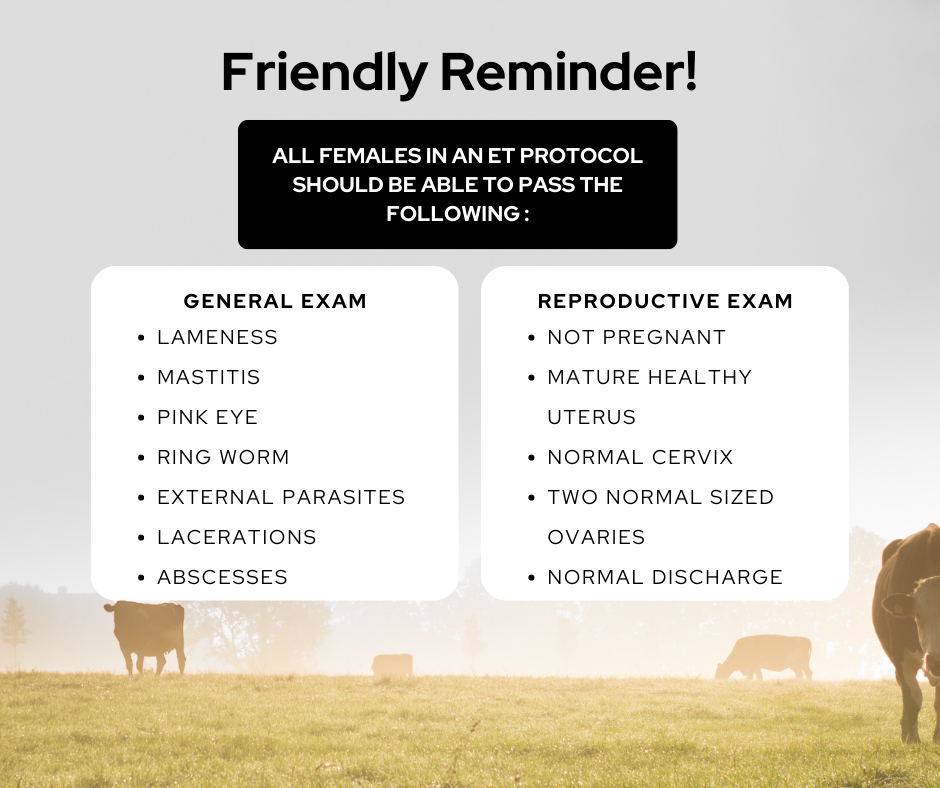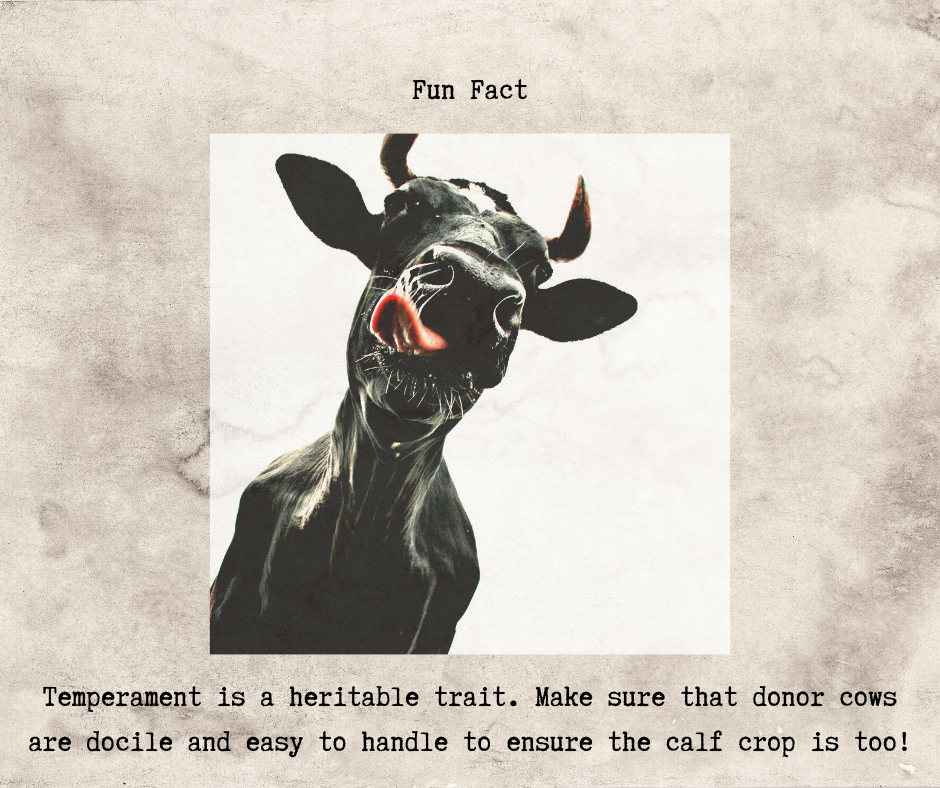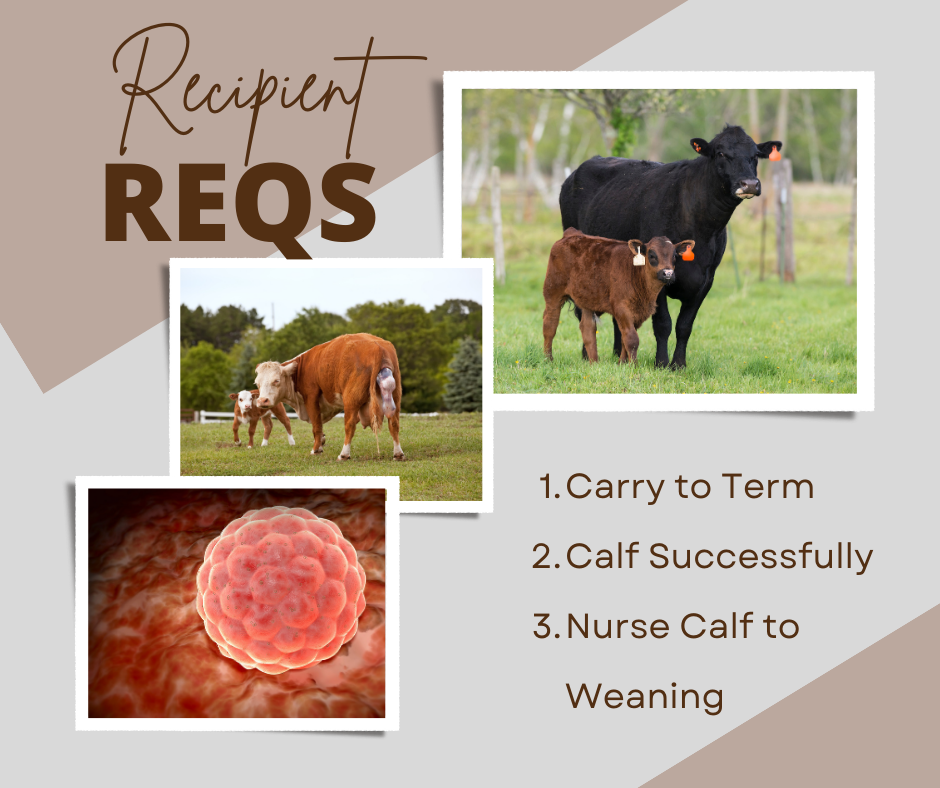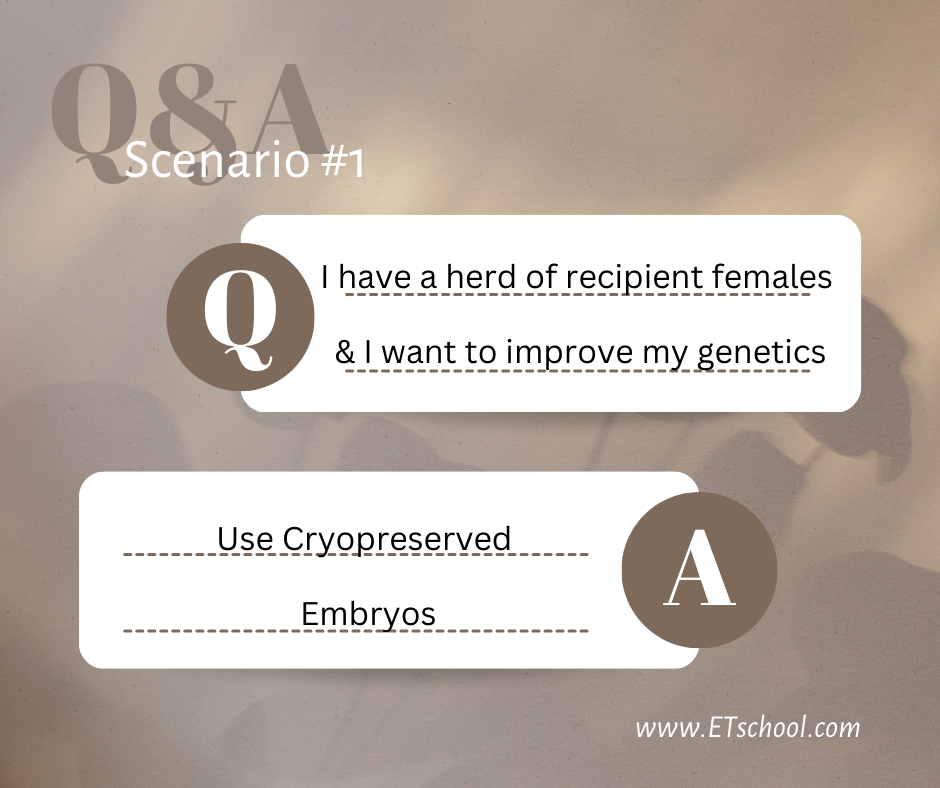
Embryo Transfer: Donors and Recipients

When implementing an embryo transfer program, it is crucial to identify which females should be donors versus recipients. Depending on your operation, one may have zero donors or all donors likewise with recipients. Regardless, donor cows and recipients should meet minimum criteria before being assigned a role within an embryo transfer program. All cows should pass a general clinical exam to identify:
- Lameness
- Mastitis
- Pink Eye
- Ringworm
- External Parasites
- Lacerations/Abscesses
If any of these are identified in recipients or donors one should consider removing them from the embryo transfer program. All these issues cause stress which can negatively impact reproductive performance leading to decreased success rates. After cows pass a general exam, a reproductive tract exam should be performed to ensure there are no reproductive abnormalities.
- Confirmation of open pregnancy status
- Mature healthy uterus
- Normal cervix (no masses)
- No abnormal discharge (bloody, brown, or green is abnormal)
- Identify two normally sized ovaries (marble to ping-pong ball sized)
Moreover, there are specific requirements for both donors and recipients that should be considered prior to enrolling them in an embryo transfer program.
High Quality Donors:
Donor cows should be well bred with good conformation and propagating their offspring should increase the genetic value of the herd. These females should be free of any genetic diseases. Moreover, super ovulation protocols, ovum pick up, artificial insemination, and flushing requires these females to spend a lot of time in the working chute. These females should be docile, work through facilities easily, stand in the chute, and be slower moving. Temperament is a heritable trait; thus, if donor cows have high strung aggressive temperaments, it is likely their embryo transfer calves will too. We recommend only utilizing registered cows for donors and mating to bulls that are top of the breed standard. This will ensure that the embryos produced can be registered with the breed association and will have a genetic makeup that is concurrent with breed standards.
Embryos from superior genetic matings that match breed standards will appeal to a larger group of cattle producers and be easier to sell for high premiums due to the high quality of the embryo.
High Quality Recipients:
Recipient cows have more requirements than donors for good reason. These females must carry the expensive embryo to term, calve successfully, and nurse the calf until weaning. This requires recipients to have specific traits that allow them to perform all these tasks.
- Carry Embryo to Term
- Calve Successfully
- Nurse Calf to Weaning
To prevent early embryonic loss, it is important to ensure that embryos are only being placed in females that are the correct age, size, and body condition score for breeding. If you are using heifers, make sure they are large framed and at least 14 months of age (18 if indicus-influenced) and have reached 80% of their mature body weight. Heifers should also be confirmed pubertal (score 4-5) by a reproductive tract scoring prior to transfer.
Heifers and cows should be at a minimum body condition score of 5 by embryo transfer. Underconditioned females have increased chance of embryonic loss, thus, transferring into skinny cows or heifers is often a waste of time and resources. Finally, if using suckled cows ensure that they have had at least 50 days after calving for uterine involution. Again, transferring an embryo into a uterus that has not had adequate rest time after calving is likely a waste.
Embryo transfer calves tend to have a larger frame size and birth weight. If using heifers, pelvic area should be measured; only use heifers that have a pelvic area greater than 180 cm2.
Any cows that have history of dystocia, calving difficulties, or that are smaller framed should not be utilized for embryo transfer. Embryo transfer calves are too valuable to utilize females that cannot successfully deliver them without assistance.
This portion of a recipient’s job is often overlooked. However, in beef cattle it is equally important to the tasks above. For beef females, you want to ensure that the recipients are maternal. This means they will defend their calves and are protective mothers. Moreover, do not use cows that have poor udder conformation as recipients. Poor udder conformation can lead to increased risk of mastitis during nursing, this quickly translates to sick calves and decreased weaning weights. It is important that the recipient dam provides the embryo transfer calf with maternal care and milk quantities that will allow the calf to reach its’ genetic potential by weaning.
After determining which females in the herd will work well as either donors or recipients, it is important to decide how you would like to utilize embryo transfer in those females to increase profits while also maintaining realistic goals for one’s operation.
I HAVE RECIPIENT FEMALES & WANT TO IMPROVE MY HERD GENETICS

The majority of producers are going to fall into this category. They have a herd of cows that would make great recipients, and instead of doing natural service or artificial insemination, these producers want to use high quality embryos to improve their genetics. The good news is this is fairly easy to accomplish with cryopreserved embryos.
If one is wanting to quickly implement embryo transfer in their herd, the easiest way is to set up herd females as recipients and purchase cryopreserved embryos. If one is familiar with estrous synchronization protocols, then setting up recipients should be simple. We recommend taking a course to become familiar with the technique and embryo thawing process prior to trying the technique. We offer a ‘Thawing and Implanting of Bovine Embryos’ course that will cover topics that guide one through the entire process.
Once this technique is implemented, producers can expect to have a more uniform calf crop that yields a higher profit. These calves can also be retained in the herd as replacement females or bulls that can increase genetic diversity.
I HAVE DONOR FEMALES & WANT TO SELL THEIR GENETICS
If one owns a seedstock operation, branching into embryo sales could yield additional profits aside from selling calves. This will require you to super ovulate donors, collect either oocytes or embryos, and cryopreserve the embryos. One could also do fresh embryo transfer, but this would require the recipient cows to be located very closely to donors.
Traditionally, embryos would be frozen and sold by the straw priced based on the breeding and genetics of the embryo. Depending on the female, one could get hundreds of embryos per year for freezing. However, this is dependent on if one chooses to use in-vitro or in-vivo embryos. The in-vitro method will require one to learn in-vitro fertilization, ovum pick up, and cryopreservation. Normally, this method will yield a higher number of embryos compared to in-vivo, but in-vivo embryos typically result in higher pregnancy rates.
We offer multiple classes that would work for these producer goals. If one is interested in learning in-vitro processes, we recommend the ‘Comprehensive Bovine Embryo Transfer Course’ followed by the ‘OPU Course’. These courses will cover everything one would need to know to perform the techniques at their operation. There is a steep learning curve to introducing this use of embryo transfer, but the economic yields from embryo sales will be drastic.
I HAVE RECIPIENTS, BUT I WANT DONORS
This is a unique situation where typically producers want to stop using cryopreserved embryos and move into using fresh embryos on their recipients. In-vivo fresh embryos have drastically better pregnancy success rates compared to their frozen counterparts. We recommend when purchasing donor females that you choose females that one would like to retain their heifers in the herd. This will allow for you to increase donor numbers after two years. Do not purchase an excessive amount of donor cows, 2-3 cows should be plenty to start depending on recipient number. We also encourage to use different bulls for each breeding to increase genetic diversity of the calf crop. At weaning, retain 5-10 females that could be potential donor cows in the future. By using this method, one is continuing to improve their genetics without having to purchase expensive donor cows yearly.
Another option is to not purchase donor cows but instead purchase several embryos from a high-quality mating. Retain those embryo calves in the herd and use them as donors once they reach reproductive maturity. We recommend the ‘Comprehensive Bovine Embryo Transfer and Artificial Insemination Course’ for these producers. It will cover all the basics of embryo transfer and artificial insemination that one will need for in-vivo embryo production, flushing, and fresh transfer from donors to recipients.
I HAVE DONORS, BUT I WANT RECIPIENTS
In recent years, the concept of leasing recipient females has become prevalent in operations that want to exclusively use embryo transfer but need more recipients. This creates an excellent opportunity for cattlemen that perhaps do not want to use embryo transfer but would like to increase their profit. Larger operations are leasing cows from smaller operations to be recipients. Essentially, the larger operations do all embryo transfer work and pay per recipient. An example of prices would be $200 per embryo transferred and $1,500 per embryo calf weaned. This would yield a net profit of $1,700 per calf for the smaller producer which easily doubles market price.
For the larger operation, it eliminates recipient feed and labor costs and allows them to focus more resources on their donor and embryo transfer efforts. The embryo calves will ultimately turn a greater profit for the larger operation than the $1700 input cost because of their genetics. Thus, it becomes a win-win situation for both producers.
For producers that have donors and want to branch into this area, we recommend the ‘Comprehensive Bovine Embryo Transfer Course’. For smaller producers, it could be beneficial for one to attend the ‘Thawing and Implanting of Bovine Embryos Course’ to learn more about the process and how to make it more successful at your operation.
Summary:
To summarize, embryo transfer can be utilized in numerous ways to yield a profit in cattle operations. Choosing the correct females to be donors and recipients is crucial for long-term success. Once females are chosen and identified, having a general plan on what type of embryo transfer program you would like to implement allows you to take next steps. We always recommended taking courses prior to implementing embryo transfer due to the expensive input costs and difficulty of the technique without proper training. We would love to help you learn how to implement embryo transfer at your operation!

|
|
|